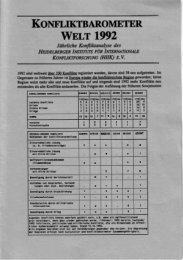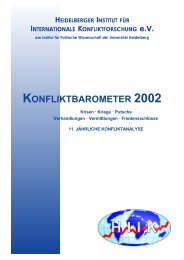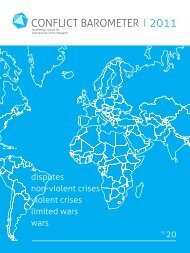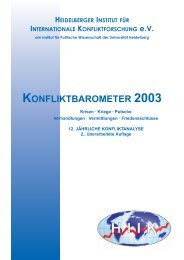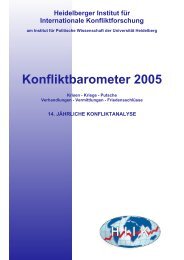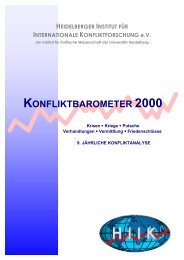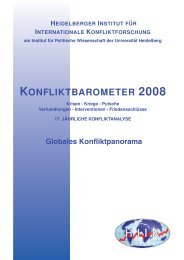CONFLICT BAROMETER 2008
CONFLICT BAROMETER 2008
CONFLICT BAROMETER 2008
You also want an ePaper? Increase the reach of your titles
YUMPU automatically turns print PDFs into web optimized ePapers that Google loves.
HIIK<br />
The HEIDELBERG INSTITUTE FOR INTERNATIONAL <strong>CONFLICT</strong> RESEARCH (HIIK) at the Department of Political<br />
Science, University of Heidelberg is a registered non-profit association. It is dedicated to research, evaluation and documentation<br />
of intra- and interstate political conflicts. The HIIK evolved from the research project ’COSIMO’ (Conflict<br />
Simulation Model) led by Prof. Dr. Frank R. Pfetsch (University of Heidelberg) and financed by the German Research<br />
Association (DFG) in 1991.<br />
Conflict<br />
We define conflicts as the clashing of interests (positional differences) over national values of some duration and magnitude<br />
between at least two parties (organized groups, states, groups of states, organizations) that are determined to<br />
pursue their interests and achieve their goals.<br />
Conflict items<br />
Territory<br />
Secession<br />
Decolonization<br />
Autonomy<br />
System/ideology<br />
National power<br />
Regional predominance<br />
International power<br />
Resources<br />
Others<br />
Conflict intensities<br />
State of<br />
violence<br />
Non-violent<br />
Violent<br />
Intensity<br />
group<br />
Low<br />
Level of<br />
intensity<br />
Name of<br />
intensity<br />
1 Latent<br />
conflict<br />
2 Manifest<br />
conflict<br />
Definition<br />
A positional difference over definable values of national meaning is considered<br />
to be a latent conflict if demands are articulated by one of the parties and perceived<br />
by the other as such.<br />
A manifest conflict includes the use of measures that are located in the stage<br />
preliminary to violent force. This includes for example verbal pressure, threatening<br />
explicitly with violence, or the imposition of economic sanctions.<br />
Medium 3 Crisis A crisis is a tense situation in which at least one of the parties uses violent force<br />
in sporadic incidents.<br />
High<br />
4 Severe<br />
crisis<br />
A conflict is considered to be a severe crisis if violent force is used repeatedly<br />
in an organized way.<br />
5 War A war is a violent conflict in which violent force is used with a certain continuity<br />
in an organized and systematic way. The conflict parties exercise extensive<br />
measures, depending on the situation. The extent of destruction is massive and<br />
of long duration.<br />
In this publication, the intensity of each conflict as shown in the tables is the highest intensity reached in the course of<br />
the year. Therefore, conflicts may, for instance, be classified as severe crises although there may have been no more<br />
fighting in the second half of the year.<br />
The present Conflict Barometer <strong>2008</strong> reflects our current state of research. Because conflict data even of previous<br />
years is continuously reviewed, this edition’s data might differ from older editions. Therefore, if you wish to trace a<br />
conflict over time, please contact us in order to receive up-to-date time series evaluations.<br />
The HIIK assumes no liability for the accuracy of the data printed in this publication.<br />
Editorial deadline: November 30, <strong>2008</strong>



